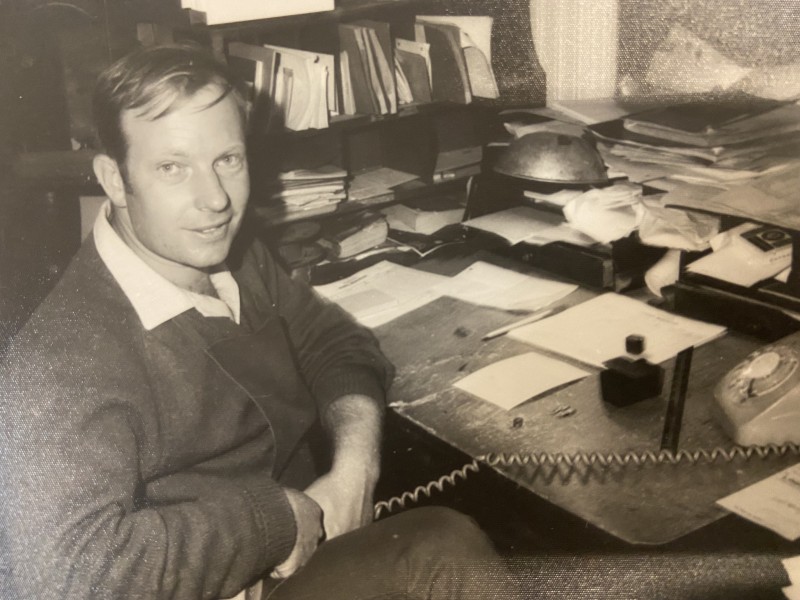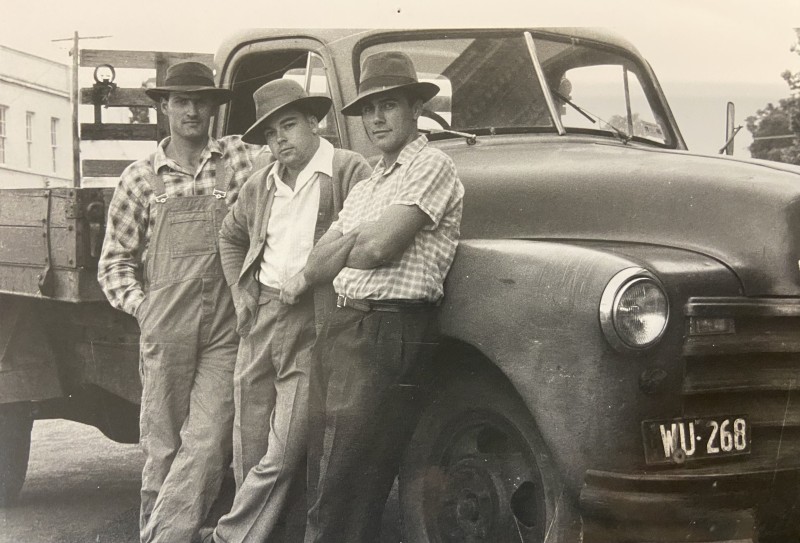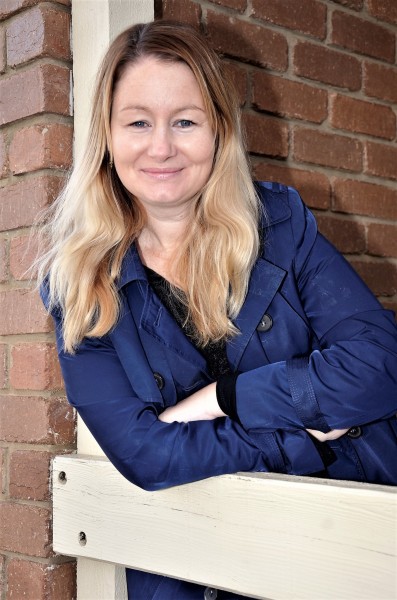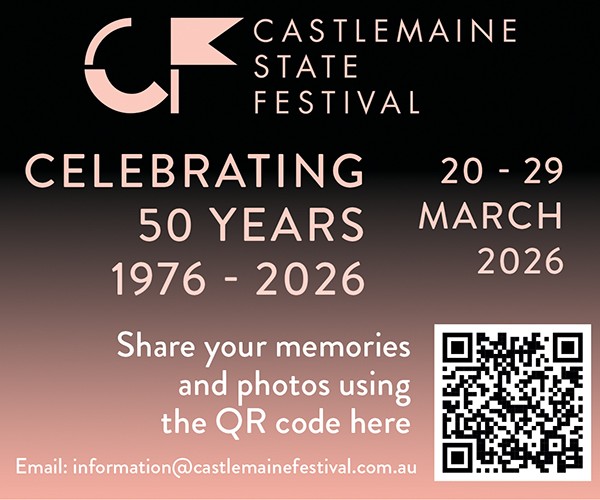
Brian Bannerman
Printer 1956-1974
I began my printing apprenticeship with the Castlemaine Mail at 155 Barker Street on April 26, 1956 as a 16-year-old. My neighbour was working there, and he ducked into my house one lunchtime to see if I wanted a job. I popped in to see the Mail boss Charlie Almond and after a quick chat was told to start work the following Friday and the rest is history.
We handset the pages on Intertype and Linotype letter press machines. Then the proofreaders would check the pages and we would have to remove and reset any lines which had errors.
I recall we used to have a bit of fun with the boys next door at Duggans Garage. We would lift up a metal flap in the fence and use a slingshot to shoot little pieces of metal at them during their tea breaks. They used to get wild. One day they retaliated with a spark plug and it struck the wall like a gun going off. Our boss Charlie Almond came bolting out the back door and flew into the lot of us! It was lucky no-one was hurt.
I worked at the Mail until 1974, then after 12 months working as a builder’s labourer, my wife Norma and I decided to start our own printing business – Golden Banner Printing – from our home in Bowden Street. As the business grew, we moved into purpose-built premises in Bruce Street in 1983. I worked as a printer until my retirement in 2004. Ink certainly runs in my veins!

Denis Cox
Printer/Manager 1963-2014
I started my printing apprenticeship at 15 with the Tarrengower Times at Maldon in January 1963. When TT operator Mr Les Smith passed away later that year, unbeknownst to me, he had organised with Mail manager Charlie Almond for me to complete my apprenticeship at the Castlemaine Mail. I started at the Mail office at 155 Barker Street in the August as a hand and machine compositor. Lance Nicholls was the foreman at the time.
After printing all the news pages the lead all got melted down into ingots to be used in the linotypes again. As the youngest I always seemed to get the job!
The Elliott Midland Newspaper Group owned by the Lanyon family later purchased the Kyneton Guardian from the Armstrong family and Lance went to Kyneton to manage the Kyneton papers. Around 1975 I transferred to Kyneton as foreman.
When Charlie Almond retired Lance sent me back to be the Castlemaine branch manager. On Lance’s retirement in 1989 I became the overall manager.
The Mail eventually moved from 155 Barker Street to 17 Hargraves Street and all commercial printing operations were relocated to Kyneton.
When our newspapers went from hot metal to offset our papers were printed at Cambridge Press Bendigo which the Elliott Newspaper Group had purchased and installed a newspaper printing press.
This was found to not be profitable and so the printing was moved to Rural Press in Gisborne and later to their dedicated facility at Ballarat.
Today the papers are printed by our sister papers in Morwell.
I started to look towards retirement in around 2012 stepping back from the management role when Lanyon family member Tim Ellen stepped up to be general manager. However, I stayed on to manage the commercial printing side of the business for another couple of years at Swan Hill, Kerang, Castlemaine and Kyneton before I eventually retired in 2014 after 51 years with the one company. The Lanyon family were great to work with. They really respected and valued their team. After 10 years of retirement, I still dream of those printing days at Barker Street most nights!
Paul Harding
Journalist 1985-1993
I started working at the Castlemaine Mail in 1985, firstly as a 17-year-old in the front office of the newly-opened Mail shopfront at 17 Hargraves St before taking up a journalism cadetship and moving into the back-office ‘news room’ in 1986.
I was fortunate enough to work, study and learn under the inimitable editor Don Gunn and manager Denis Cox. Bill Maltby was sales manager at the time.
The mid-eighties was a simpler time for technology and country newspaper life. Bob Hawke was prime minister and we were tapping away on manual ribbon typewriters and shooting with black-and-white film cameras. The only phones were on our desk and attached to the wall. The steel-grey camera cupboard contained a Nikon, a Pentax, a Ricoh and a flash the size of a periscope. None of us really knew how to use them properly but we learned as we went and hoped for the best when the rolls of film were sent by car to the darkroom in Kyneton. We took pride in our work though and the results were almost always surprisingly good. We typed what we hoped was scintillating or informative copy on little slips of yellow paper that were collated at the end of the day and driven to Kyneton for typesetting – until the fax machine arrived to change our lives. The smudged shiny fax paper seemed barely readable at times, but it was a technological breakthrough! It was even more exciting when we upgraded to a basic computer system and modem file transfers in the early 90s.
I loved working at the Mail for many reasons. It was a focal point for news and information in the community, as it is today, and an exciting place to be. As editor, Don took care of many of the ‘big’ stories in the early days (visiting politicians, controversial council matters and the like) but he was a generous editor and we shared the work around, covering sports, community events, council meetings, entertainment, crime, courts, environmental issues and human interest, all with a local paper perspective. There was always a procession of people filing through our office to get the ear of a reporter or drop off barely legible handwritten sports results, club notes or letters to the editor for inclusion in the next edition. More often than not we were out of the office, interviewing someone, photographing something or attending an event somewhere. It was never dull.
Every Thursday we would head down to the Kyneton production office to help put the weekly Friday edition to bed – it was hand composited then with columns of printed text and headlines carved up with a scalpel and pasted onto large boards by skilled compositors.
Anything that didn’t fit in the layout was ‘cut from the bottom’. The free Midland Express was the main regional newspaper but we were passionate about keeping the Mail going strong as it was a truly local Castlemaine paper, and always well-supported, even with a 10 cent cover charge. There was some intriguing but short-lived competition from a new independent paper called the Central Victorian News & Review which set up an office directly across the street from us in 1988. It folded a year later.
Sport was always a great source of community news and we saw lots of young local athletes go on to bigger things. The Sun Tour cycling race used to have a stage finish in Castlemaine which was a huge event. I vividly remember Castlemaine Magpies winning the premiership in the 1992 Bendigo Football League by less than a goal – the first since 1966 – and the wild afterparty at the Old Castlemaine Gaol. It was a Sunday and I was (somewhat lightheartedly) threatened with early retirement by Don after turning up very late to work on Monday. Chewton’s 1986 premiership and Campbells Creek kicking 100 goals against Primrose in 1990 were also memorable to me.
Big stories I remember from the time included the closing of the old gaol and the opening of Loddon Prison in 1990, the sad raid on the Chewton dingo farm in 1990, various redevelopments such as the Castlemaine Town Hall, drill hall (a new gym) and railway goods shed (indoor sports), and guitarist Brett Garsed going from local plumber to Australia’s biggest band with John Farnham and Whispering Jack in 1986. I enjoyed covering the Castlemaine State Festival every two years, odd-ball events such as the Campbells Creek Cup Camel Races and Mt Tarrengower Hill Climb, cool things like annual hot rod and truck shows and the world premiere of Crocodile Dundee at the Theatre Royal in 1986.
Location filming for TV or movies wasn’t as common at the time but I covered the filming of the miniseries Nancy Wake, interviewing Noni Hazlehurst in a Harcourt forest in 1986 and, with colleague Matt Lane and lots of other locals, appeared as an extra in the miniseries Snowy in 1993, when Castlemaine’s streetscape, including our newspaper office, was transformed into 1950s Cooma.
I left the Mail in 1993 to travel and work overseas, which eventually led me to Lonely Planet, a global travel publisher based in Melbourne, where I’ve worked as a travel guidebook writer, photographer and book editor for more than 20 years. Since Covid, I also work as a freelance photographer.
The Castlemaine Mail was an amazing place to work and start my career, and I feel privileged and humbled to have been a part of its rich history.

Matt Lane
Journalist 1990-1993
I started as a cadet journalist with the Castlemaine Mail at the beginning of 1990 when the office was at 17 Hargraves St.
It was a very different world back then. We wrote our stories on typewriters and faxed the finished product off to Kyneton to be typeset. All the photos we took were black and white and had to be converted into a dotted replica to be able to print them in the paper. There were no mobile phones, no email and no social media.
Because of these factors it was, in some ways, harder to do the job of a journalist than it is now, but then, we didn’t have the deadline pressure of today’s reporters and the 24-hour news cycle.
I started my cadetship under the tutelage of then-editor, Don Gunn, and graded journalist Paul Harding. Because it was a small operation, there was – with some exceptions – no great difference between the stories I did and those my more experienced colleagues tackled. I did reports on sport, council meetings, police issues, human interest, business, real estate, visits by state and Federal politicians – it was the full gamut!
Perhaps the biggest story during my time at the Mail was the day that the RSPCA raided a dingo farm in the bush just out of Chewton. The farm boasted dozens of pure-bred dingoes and was something of a tourist attraction.
One morning, Don received a phone call, and instructed me to grab a camera and follow him as he sped in his little orange Holden Torana out to the farm. I duly followed in my car, the office’s old Pentax camera bouncing on the seat beside me.
When we go there, Don whispered, “Just take lots of photos” before hurtling down the compound where armed RSPCA officers stood in a rather tense stand-off. It was around this time that I came to horrifying realisation that the camera I was carrying contained no film (this was waaaay before digital cameras).
Regardless, but with reddening ears, I played the role of dutiful photographer, pointing the big heavy lens at everything that moved and rhythmically tapping the shutter button. It wasn’t quite as bad as it could have been, though, as Don also had a camera – with film – and was clicking away as well.
The story became interesting when one of the officers, under instruction from a superior, proceeded to shoot five of the dingoes. It was apparent that RSPCA believed the dingoes were being mistreated and required euthanising.
Anyway, it was front page news for the Castlemaine Mail that week, with a two-page story under the banner headline “The Day the Dingoes Disappeared”. It was entirely written by Don – with Don’s photos – but the very generous by-line: By Don Gunn and Matt Lane.
And that’s how I scored my first front-page story!
I left the Mail in 1993 to become a sub-editor at a community paper in Albury. From there, I went on to become a television news reporter, travel author and communications professional. It was the grounding I received back then that set me up for a successful and fulfilling career.
Lisa Dennis (nee Lowry)
Journalist/Editor 1997-Current
My involvement with the Mail began 33 years ago as a 15-year-old Media Studies student at the Castlemaine High School, now CSC, when I began writing Castlemaine District Junior Football League reports. I later enjoyed work experience at the Mail with Don Gunn, Paul Harding and Matt Lane before attaining a journalism cadetship at our sister paper the Kyneton Guardian/Midland Express in Kyneton in 1997.
After 18 months training under the watchful eye of editor Don Gunn and Senior Journalist Valerie Hornbuckle, I transferred to Castlemaine to work with my long-time mentor – senior journalist Dawn Felstead. I later worked as Senior Journalist to experienced long time metro Editor Jeff Jones before taking on the role of Castlemaine Mail Editor eight years ago on his retirement.
In my 27 years covering local news, I have interviewed people from all walks of life – premiers, actors, musicians, artists, tradespeople, sportspeople and a host of passionate community members, selfless volunteers, and businesspeople.
Highlights for me include flying across Castlemaine in an Airforce Hot Air Balloon, chatting to local Lot 19 creatives about a full-scale dinosaur they had made for a museum exhibit in Western Australia, and meeting a US artist who created an Australiana-themed throne with the support of the team at Billmans Foundry as part of the Lorne Sculpture Biennale. Every week my community never ceases to amaze me. There is never any shortage of local news, and it has been my honour to play a small part in the long and proud history of our local publication.


